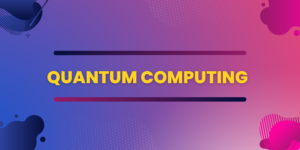Functions of Quantum Computing lie at the heart of this transformative technology the quantum bit, or qubit. This article explores the functions of quantum computing, shedding light on how qubits enable computational capabilities beyond the reach of classical computers.
Understanding Qubits: The Building Blocks of Quantum Computing
1. Superposition:
Classical bits exist in a state of 0 or 1. Qubits, however, can exist in a superposition of both states simultaneously. This ability to exist in multiple states forms the foundation for parallel computation in quantum systems.
2. Entanglement:
Qubits can be entangled, meaning the state of one qubit is directly correlated with the state of another, regardless of distance. Entanglement enables instantaneous communication and coordination between qubits, enhancing computational efficiency.
3. Quantum Interference:
Quantum interference allows qubits to combine or cancel each other’s probabilities during computation. This phenomenon enables the optimization of computational paths, leading to more efficient problem-solving.

To learn more about the above important definitions please click on the following link [click here]
Functions of Quantum Computing
1. Parallel Computation:
Quantum computers excel at parallel computation due to qubits existing in superposition. This allows them to evaluate multiple possibilities simultaneously, offering unprecedented speed for certain types of calculations.
2. Exponential Speedup in Certain Algorithms:
Quantum algorithms, such as Shor’s algorithm for factoring large numbers and Grover’s algorithm for searching unsorted databases, demonstrate exponential speedup compared to their classical counterparts. These algorithms leverage the unique properties of qubits to solve specific problems significantly faster.
3. Optimization and Simulation:
Quantum computers are particularly well-suited for optimization problems, such as finding the most efficient route in a network or optimizing financial portfolios. Additionally, they excel at simulating quantum systems, providing insights into molecular interactions and materials at a level of detail beyond classical simulation capabilities.
4. Machine Learning and AI:
Quantum computing has the potential to revolutionize machine learning and artificial intelligence. Quantum algorithms can enhance pattern recognition, optimization tasks, and the training of complex neural networks, opening new avenues for AI applications.
5. Secure Cryptography:
Quantum computers pose a threat to classical cryptographic systems through their ability to quickly solve certain mathematical problems. However, quantum cryptography offers secure alternatives, utilizing the principles of quantum mechanics to create unbreakable cryptographic protocols.
Main Challenges
1. Quantum Decoherence:
Qubits are delicate and susceptible to environmental interference, leading to a loss of coherence. Quantum error correction techniques are essential to mitigate the effects of decoherence and maintain the integrity of quantum computations.
2. Scalability:
Scaling up quantum systems to handle a large number of qubits without compromising performance is a significant challenge. Researchers are exploring various approaches, including the development of quantum error correction and fault-tolerant quantum computers.
3. Universal Quantum Computers:
Building universal quantum computers that can tackle a broad range of problems remains a complex task. Current quantum computers are specialized for specific tasks, and achieving universality is an ongoing pursuit in quantum computing research.

Future in Quantum Computing
1. Hybrid Quantum-Classical Systems:
Hybrid quantum-classical systems, where quantum processors work in conjunction with classical processors, represent a pragmatic approach to overcoming current challenges and leverage the strengths of both classical and quantum computing.
2. Quantum Cloud Computing:
The emergence of quantum cloud computing services allows researchers and organizations to access quantum processing power remotely. This democratization of quantum resources accelerates research and development in quantum computing applications.
3. Interdisciplinary Collaboration:
The future of quantum computing relies on interdisciplinary collaboration. Physicists, computer scientists, mathematicians, and engineers working together can drive innovations, address challenges, and unlock the full potential of quantum computing.
Conclusion
In conclusion, the functions of quantum computing, empowered by the unique properties of qubits, offer a glimpse into a new era of computational capabilities. From parallel computation to exponential speedup in specific algorithms, quantum computing has the potential to revolutionize industries and solve complex problems that classical computers find challenging.
Frequently Asked Questions (FAQs)
What are qubits and how do they differ from classical bits?
Ans-Qubits, or quantum bits, can exist in a superposition of 0 and 1 simultaneously, allowing for parallel computation. This contrasts with classical bits, which exist in a definite state of either 0 or 1.
How does quantum entanglement contribute to quantum computing functions?
Ans- Functions of Quantum Computing, Quantum entanglement enables instantaneous communication and coordination between qubits, enhancing computational efficiency by creating correlations between quantum states.
What are some applications of quantum computing?
Ans- Quantum computing has applications in parallel computation, exponential speedup in specific algorithms, optimization and simulation, machine learning and AI, and secure cryptography using quantum principles.
What challenges does quantum computing face?
Ans- Challenges include quantum decoherence (loss of coherence in qubits), scalability issues, and the quest for building universal quantum computers capable of solving a broad range of problems.
What are the future directions in quantum computing?
Ans- Future directions include hybrid quantum-classical systems, quantum cloud computing services, and interdisciplinary collaboration among physicists, computer scientists, mathematicians, etc.
Also, learn 8 main Limitations of Quantum Computers
Quantum Computer Speed: Incredible Power of the Future
https://www.ionos.com/digitalguide/hosting/technical-matters/quantum-computing/


1 thought on “5 main Functions of Quantum Computing: Unleashing the Power of Qubits”